Planning a trip to Kyoto and wondering Where To Stay In Kyoto? You’re in the right place. Kyoto, with its breathtaking temples, serene shrines, and captivating culture, offers an overwhelming array of attractions. Choosing the right location and type of accommodation can significantly enhance your experience in this historic Japanese city. Whether you’re seeking a luxurious hotel, a traditional ryokan, a charming machiya, or a comfortable Airbnb, this guide provides expert recommendations to help you make the best choice.
Having spent considerable time in Kyoto over the last decade, staying in various types of accommodations – from hotels and ryokans to machiya and Airbnb rentals – we offer firsthand insights to guide your decision. This isn’t just a compilation of popular spots; it’s based on genuine experiences, both positive and negative, from our own travels in Kyoto.
Let’s begin with location, a crucial factor regardless of your accommodation style. If your Kyoto visit is brief, two days or less, consider extending it to truly appreciate the city. However, if time is limited, focus on a specific area that aligns with your interests to avoid wasting precious time traveling across the city.
For short trips, we recommend staying near Inari. This location offers easy access to the iconic Fushimi Inari Shrine and convenient connections to Higashiyama. Higashiyama itself is another excellent, though slightly pricier, option with numerous hotels and rentals. We particularly suggest Southern Higashiyama over Northern Higashiyama for its charm and accessibility.
 Fushimi Inari Shrine area Airbnb in Kyoto, Japan
Fushimi Inari Shrine area Airbnb in Kyoto, Japan
For stays of three days or longer, proximity to a transportation hub becomes more beneficial, allowing you to explore all corners of Kyoto with ease. Kyoto Station is the prime choice, serving as the city’s central transportation hub. From here, you can effortlessly reach any part of Kyoto, as well as venture to Osaka and Tokyo.
Another favored location is just north of Kiyomizu-Gojo Station in southern Gion. We’ve returned to this area multiple times, preferring its quieter, less tourist-packed atmosphere compared to central Gion. Its convenience to the Keihan Line, our preferred Kyoto railway, and walking distance to the Higashiyama District make it highly appealing. Similar advantages draw us to the Fushimi Inari area.
 Gion district Airbnb in Kyoto, Japan
Gion district Airbnb in Kyoto, Japan
Downtown Kyoto, while often recommended, is not our top choice, except for the area closest to the Kamo River. Although centrally located with abundant restaurants, nightlife, shopping, and transport links, Downtown Kyoto feels more urban and industrial. If you seek a city vibe akin to Tokyo or Osaka, Downtown might suit you. However, for an immersive Kyoto cultural experience, other areas offer more charm.
Arashiyama, a traditional and touristy area in western Kyoto, has accommodations, but we hesitate to recommend it for first-time visitors. Its distance from other key areas and less convenient public transport can be drawbacks. While Arashiyama has its appeal, locations closer to the city center provide better access to Kyoto’s diverse attractions. We generally advise against staying west of Kyoto Station.
Now, let’s explore the various types of accommodations available in Kyoto, starting with hotels.
Our Recommended Hotels in Kyoto
When choosing hotels in Kyoto, consider whether you prefer Western or Japanese style accommodations. Kyoto has seen a surge in luxury Western hotel chains in recent years, including Hyatts, Four Seasons, Ritz-Carlton, and boutique brands. Here are some of our favorite hotels, categorized by area:
Top Hotels in Higashiyama & Gion
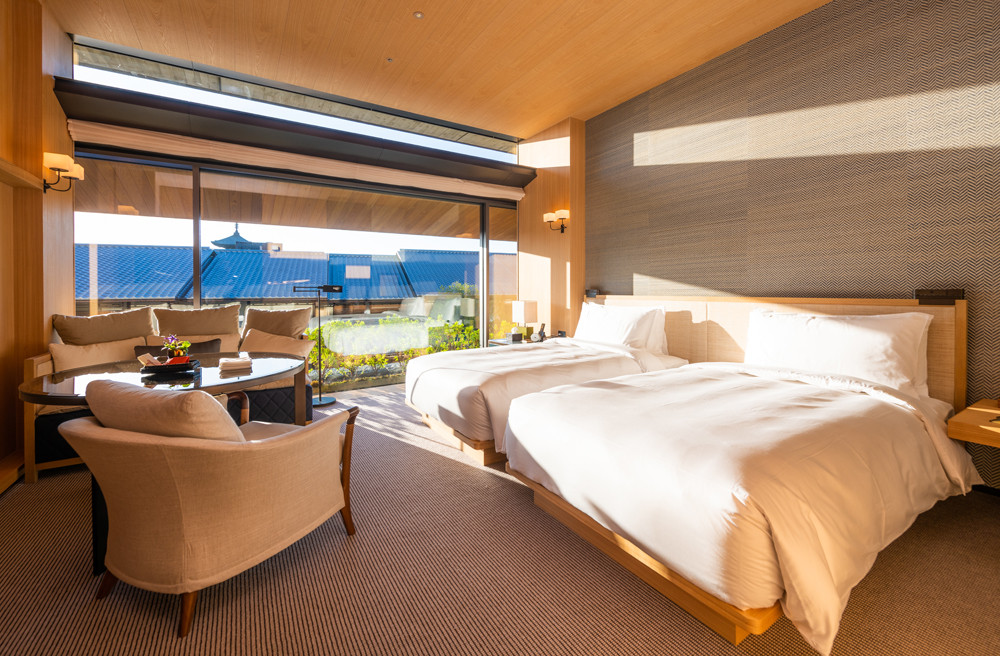 Park Hyatt Kyoto lobby area, a luxury hotel in Higashiyama, Kyoto, Japan
Park Hyatt Kyoto lobby area, a luxury hotel in Higashiyama, Kyoto, Japan
-
Park Hyatt Kyoto: Our absolute favorite and one of the best hotel experiences worldwide. This top-tier hotel boasts understated elegance, beautiful woodwork, tranquil spaces, well-appointed rooms, and an ideal location for exploring Higashiyama. Read our detailed Park Hyatt Kyoto Review for more insights.
-
Hyatt Regency Kyoto: Before the Park Hyatt’s opening, this was Kyoto’s premier Hyatt. A solid hotel within the Regency brand, offering comfortable rooms, good dining, and a decent Higashiyama location (though less prime than the Park Hyatt). It’s a more affordable alternative to the Park Hyatt.
-
Four Seasons Kyoto: Situated near the Hyatt Regency, its location is suitable for the Regency but less so for a flagship luxury hotel with high rates. While it provides the classic Four Seasons experience, it’s challenging to recommend it over the Park Hyatt or Ritz-Carlton Kyoto.
-
Westin Miyako Kyoto: Located in the same area, it’s a less compelling option. Recently renovated, it has improved, but doesn’t quite reach the level of other luxury hotels in the vicinity.
Best Hotels in Downtown Kyoto
 Hotel Okura Kyoto lobby, a well-located hotel in downtown Kyoto, Japan
Hotel Okura Kyoto lobby, a well-located hotel in downtown Kyoto, Japan
-
Hotel Okura Kyoto: Our top downtown pick, combining convenience with excellent value. While slightly dated in its 1990s luxury style, it’s well-maintained and conveniently connected to Kyoto Shiyakusho-mae Station.
-
Ritz-Carlton Kyoto: One of the finest Ritz-Carlton hotels globally, located on the Kamo River bank. It features spacious, luxurious rooms with river and Higashiyama Mountain views. Its eastern Downtown location offers easy access to both the city center and Gion/Higashiyama.
These Downtown Kyoto hotels benefit from being on the eastern edge of the area, close to the Kamo River. This provides a balanced experience, offering downtown convenience while being near Gion and Higashiyama, with ample dining and transport options.
Prime Hotels Near Kyoto Station
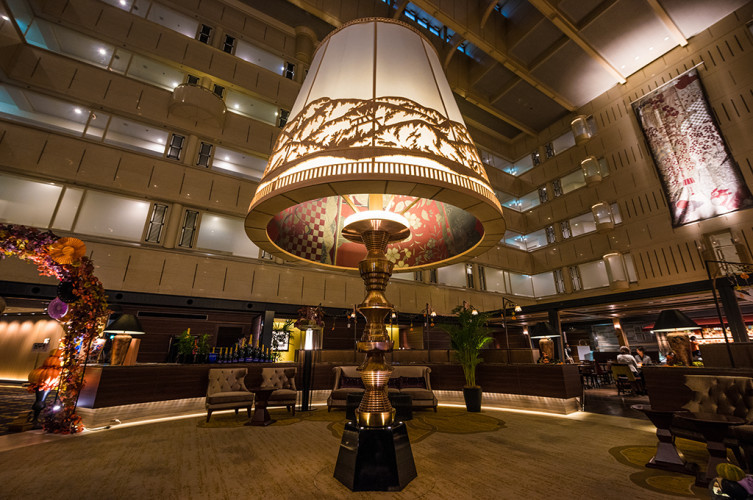 Kyoto Century Hotel lobby with distinctive lamps, close to Kyoto Station
Kyoto Century Hotel lobby with distinctive lamps, close to Kyoto Station
-
Kyoto Century Hotel: A standout hotel near Kyoto Station, praised for its location and quality. Just a 5-minute walk from the station, its interior is pleasant, blending Japanese and Western room styles.
-
Hotel Granvia Kyoto: Directly above Kyoto Station, ideal for Japan Rail Pass holders exploring beyond Kyoto. While not exceptional in itself, its spacious rooms and on-site dining, combined with unparalleled convenience, make it a strong choice.
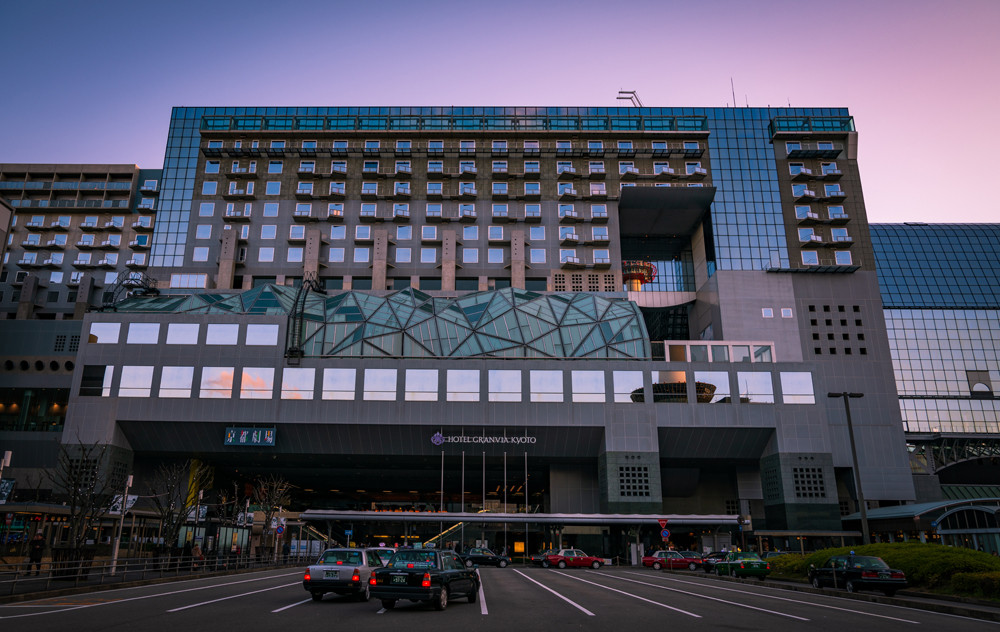 Hotel Granvia Kyoto exterior, located above Kyoto Station
Hotel Granvia Kyoto exterior, located above Kyoto Station
Beyond these, luxury “retreats” are emerging on Kyoto’s outskirts, particularly in Arashiyama. Top luxury resorts include Suiran, a Luxury Collection Hotel, Kyoto and Hoshinoya Kyoto.
Northwestern Kyoto also hosts Aman Kyoto and Roku Kyoto, nestled in the foothills of Mount Daimonji. These are destination resorts, offering secluded luxury. However, their remote locations can make exploring Kyoto’s main attractions challenging. Similarly, the trendy Ace Hotel and Hotel the Mitsui Kyoto (near Nijo Castle) are located further west of Downtown Kyoto, which might be less convenient for sightseeing.
While these luxury retreats are undoubtedly beautiful, their isolation might detract from experiencing the heart of Kyoto. For a truly immersive Kyoto trip, staying closer to the central areas is generally recommended. Save secluded luxury escapes for other destinations.
Ryokan: Experience Traditional Japanese Hospitality
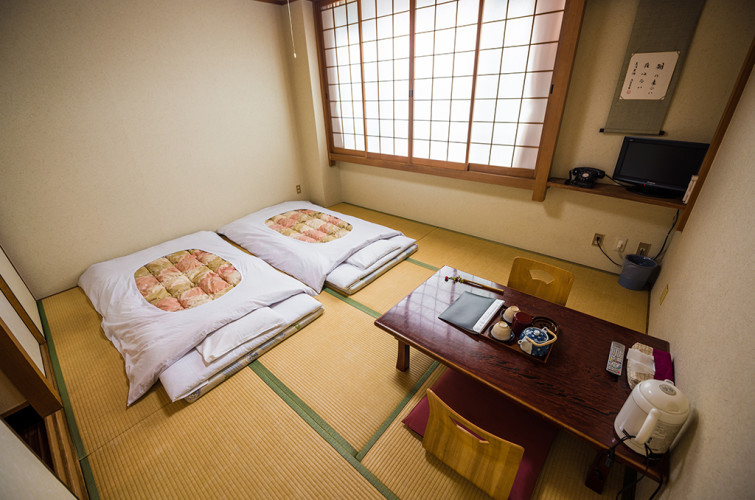 Traditional ryokan room in Japan with tatami mats and futon bedding
Traditional ryokan room in Japan with tatami mats and futon bedding
A ryokan is a traditional Japanese inn, dating back to the Edo period, offering a unique cultural experience. Ryokans typically feature tatami-matted rooms, yukata robes for guests, and communal areas. Some include communal baths, initially a daunting concept for some but a culturally enriching experience. Ryokans, generally more spacious, are more common outside of densely populated Tokyo.
While sleeping on a futon on tatami mats might seem unconventional, the bedding is surprisingly comfortable, often comparable to Western hotel mattresses in Japan. Concerns about communal bathing are quickly overcome as it’s a normal part of Japanese culture, with many ryokans also offering private bathroom options.
We highly recommend considering a ryokan for an authentic Japanese experience. It’s a quintessential part of Japanese culture worth embracing. If the ryokan concept is unappealing, sticking to Western-style hotels in Kyoto might be preferable. Note that Japanese bedding tends to be firmer than Western standards, and ryokan futons are generally quite comfortable in comparison.
Machiya: Stay in a Traditional Kyoto Townhouse
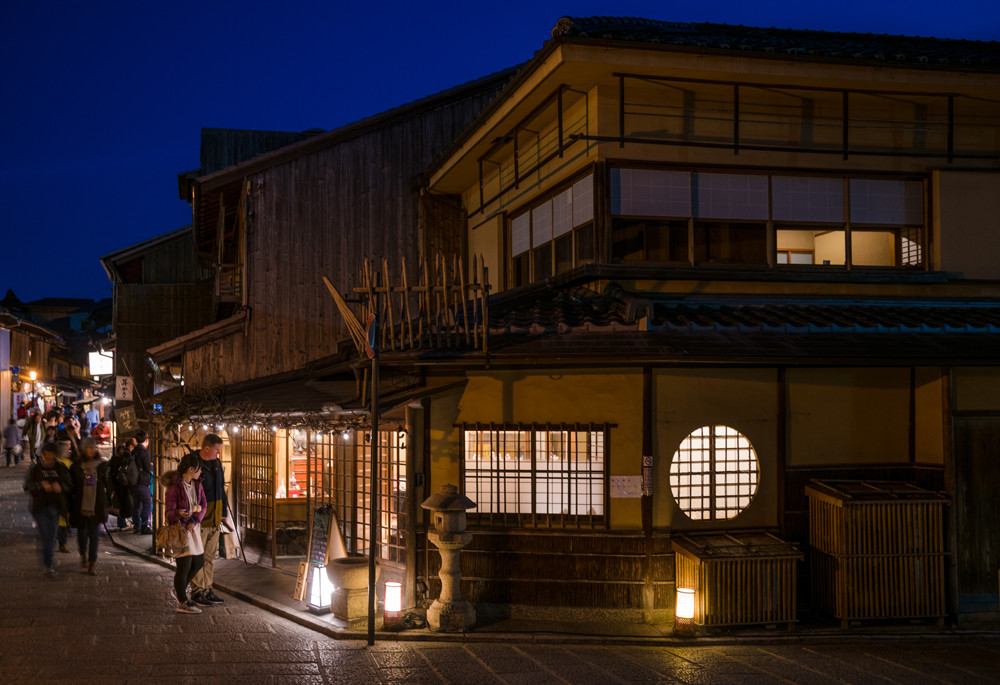 Higashiyama district street with traditional Machiya houses in Kyoto, Japan
Higashiyama district street with traditional Machiya houses in Kyoto, Japan
Machiya are iconic traditional wooden townhouses of Kyoto, representing classic Japanese architecture. Popular in the last century until post-WWII development, many machiya still stand today. Efforts are ongoing to restore and repurpose them, with some becoming vacation rentals, shops, or restaurants, including even a Starbucks.
Machiya interiors embody Japanese design with tatami floors, minimalist décor, fusuma sliding doors, and exposed wood. The design is simple yet refined, with pleasing details that create inviting spaces.
We highly recommend staying in a machiya for a truly immersive experience. In Kyoto, they are mainly found in Gion and Higashiyama, excellent areas to stay. (Some are in Arashiyama, but as mentioned, we don’t recommend Arashiyama as enthusiastically for first-timers.)
Machiya can be booked through Airbnb or hotel booking sites, generally at a premium over standard accommodations. However, the unique, distinctly Japanese experience is often worth the extra cost. We suggest exploring Airbnb for machiya stays over booking a machiya hotel for potentially more authentic and varied options.
Airbnb: Your Home Away From Home in Kyoto
 Fushimi Inari Shrine area Airbnb in Kyoto, Japan
Fushimi Inari Shrine area Airbnb in Kyoto, Japan
We frequently explore Airbnb for accommodations, particularly during peak travel seasons in Japan like sakura season, autumn foliage, and Golden Week, when hotel prices surge. Airbnb often provides more spacious options, like entire apartments, compared to typically smaller Japanese hotel rooms (excluding Western chains). Many Airbnb flats adopt a “ryokan style,” offering a touch of local culture. (If preferred, you can also find Airbnbs with Western-style beds.)
The primary advantage of Airbnb is often better value for money. Many rentals accommodate larger groups without extra per-person charges (common in Japanese hotels). Additionally, hosts often provide portable Wi-Fi (MiFi), convenient for travelers. We’ve enjoyed numerous positive Airbnb experiences in Japan and highly recommend it.
Our Kyoto Airbnb experiences include several month-long stays near Kyoto Station, Fushimi Inari, and Gion/Higashiyama. For longer stays with Kansai region side trips, Kyoto Station or Gion are excellent bases.
For shorter 2-3 day trips, the Fushimi Inari area is ideal. Although we prefer longer Kyoto visits, for short stays, we’d readily re-book our past Fushimi Inari Airbnb.
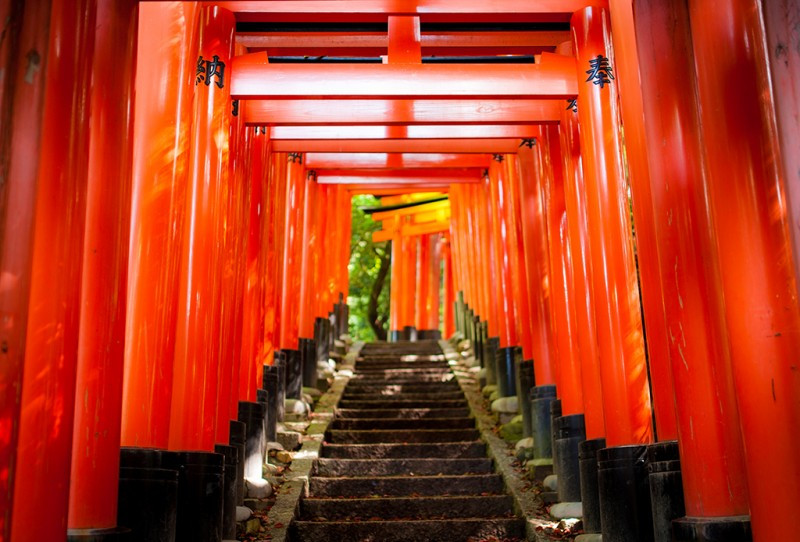 Fushimi Inari Shrine in Kyoto, Japan, a popular tourist destination
Fushimi Inari Shrine in Kyoto, Japan, a popular tourist destination
While you don’t need to book our specific Airbnb, the general location is superb. Kiyomizu-Gojo and Inari stations are on the Keihan Line, simplifying access to Higashiyama attractions, from Philosopher’s Path to Kiyomizu-dera Temple. Fushimi Inari, open 24/7, is perfect to visit late at night or early morning, avoiding crowds and extending your sightseeing day. Experiencing Fushimi Inari at sunrise or night is truly special.
Hopefully, this guide clarifies where to stay in Kyoto and simplifies your accommodation decision. While the choices might seem complex, understanding the nuances of location and accommodation types will help you make an informed and satisfying choice for your Kyoto adventure. Choosing wisely is crucial, as a less-than-ideal choice can impact your Kyoto experience (as we learned on our first visit!). With the right information, making a great decision becomes much easier. We trust this guide sets you on the right path!
Planning your Japan trip? Start with our Ultimate Guide to Kyoto, Japan for comprehensive vacation planning. Explore our other Japan posts for more travel inspiration!
Share Your Thoughts
Have you been to Kyoto? Where did you stay? Would you recommend it? Share your tips and experiences in the comments to help fellow travelers! Questions about specific hotels, ryokans, or Airbnbs? Ask away in the comments! Your insights and questions are valuable to our community.
